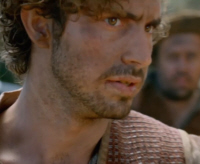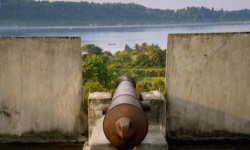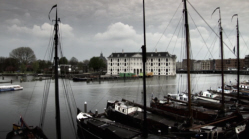Nutmeg Trade - Competition Battle
But the setback in Japan couldn’t stop the growth of world trade. Europe’s entrepreneurs created a powerful new way to make money - companies.
Their rivalry would only increase the competition for rare and exotic goods. Ginger, cloves, cinnamon travelled around the world, making merchants fortunes. And there was one spice, fabulously expensive from Europe to India, which was prized above all, rumoured to be a cure for the plague… nutmeg.

But nutmegs grew only in a few tiny islands, sandwiched between Borneo and New Guinea - the Banda Islands.
The Dutch controlled nine of the 10 islands, with forts, ships and thousands of men. The English controlled just one - their very first colony - the island of Run.
It still looks much as it did in 1600, just a two-mile strip of steep hills and nutmeg trees. But in those days a single sack of nutmeg could buy you a townhouse in London.
Run was held by the world’s first multinational corporation, the East India Company of London.

In January 1617, Nathaniel Courthope’s job was to keep the island from the Dutch competition. He trained his Canon in a gap in the reefs. He had two ships - the rival Dutch East India Company had a dozen. This looks like a traditional naval battle. It’s really a hostile corporate takeover.
The Dutch East India company had a stranglehold on the world trade in nutmeg and other spices. The future was Dutch. As for the British, they were, frankly, comparative tiddlers.

Amsterdam was the headquarters of the Dutch East India company, the VOC. The Dutch had overtaken the Portuguese and Spanish in the Asian spice trade, for a good reason. Unlike the Spanish kings, who spend their wealth, the Dutch merchants joined together in companies and reinvested their earnings in more ships, more expeditions, until soon, they had the biggest Navy on Earth.
With nothing but rainwater to drink on Run, an English ship tried to run the blockade to get fresh water. But it was captured. Finally, some of Courthope’s own men deserted, taking the last ship. The only means of escape was now gone.
Months of stalemate followed. Then a deserter from the Dutch navy appeared out of nowhere and asked for protection. Courthope took him in… though his men were wary.
The English survived on rainwater and scraps for three more years. All the while, the Dutch deserter lived quietly amongst them, until Courthope received a message. It was from native Banda islanders offering to fight the Dutch.
On the night of October 18, 1620, Courthope went to meet rebels. But the deserter finally succeeded in his act of corporate espionage. The Dutch were waiting for Courthope. Nathaniel Courthope was never seen again.
With their leader gone, the English surrendered. The English trade in nutmeg was over. The Dutch East India Company was on its way to becoming the largest commercial power in the world.

But there was one final consequence of Nathaniel Courthope’s heroic last stand on Britain’s very first colony. When the British and Dutch finally agreed a peace treaty, the British were able to ask for something back, in return for handing over the rights to Run. And what they got was the rights to another diddly little island on the other side of the world - it was called Manhattan.
And a certain amount of capitalism carries on there, even today.
